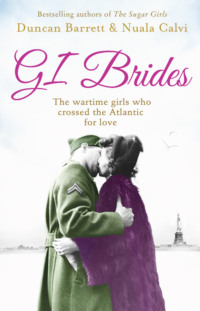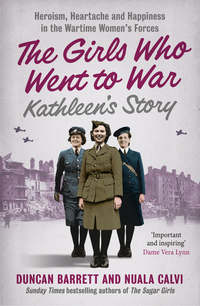
Полная версия
The Girls Who Went to War: Heroism, heartache and happiness in the wartime women’s forces
Every moment of the day was accounted for – the girls were told when to wake up and when to go to sleep, even when to visit the communal washing facilities, or ‘ablutions’, where they were allowed to shower three times a week. The lack of privacy there was just part of the ATS way of life – a reminder that, like every item of kit, the girls’ bodies belonged to the Army.
The one small touch of individuality they were allowed was a little shelf above each bed, where they could place a few personal items. Jessie had proudly displayed a photograph of Jim, and she saw that many of the other girls also had pictures of their sweethearts back home.
Despite the busy training schedule, Jessie wrote to her fiancé every couple of days, but she was kept so busy that she barely had time to miss him. In the evenings the girls in her hut would stay up singing and chatting together until lights out at 10.30 p.m., and if they weren’t cleaning and polishing their uniforms while they did it, they were doing embroidery. There was a concession in the barracks that sold the patterns, and Jessie was working on a tablecloth.
If the first part of ATS training was about instilling a respect for Army discipline, the second was for sorting the wheat from the chaff. The girls lined up in an exam hall to sit a series of intelligence and aptitude tests, with questions on general reasoning and mathematics. There they were asked to write an essay about their lives before they had signed up, to assess their spelling and grammar.
When the written exams were out of the way, they were given eye checks to establish how far they could see, and a steady-hand test where they had to avoid setting off a buzzer. Then there were memory and visual recognition tests, in which cards showing various German planes were flashed in front of them and they had to try to remember which was which.
By the time Jessie was led into a little room and asked what trade she would like to be considered for, her head was spinning, but she confidently proclaimed, ‘Ack-ack, please.’ A corporal made a note on a clipboard and sent her on her way.
Finally, at the end of their time at the training camp, the girls all gathered to be assigned to their postings. As a corporal read their names off a list one by one, they waited anxiously to hear what their future in the Army would be. Some trades, such as cook, were so unpopular that girls had been known to go to extreme lengths to get out of them, as evidenced by the occasional dollop of mustard in the morning’s porridge.
Since Jessie’s surname was Ward, she was one of the last to hear what role she had been assigned to. Mary and Olive had already been told they were going to an ack-ack training camp in Berkshire, and she crossed her fingers, hoping that she would be setting off with them.
Finally, the corporal came to her name. ‘Private Ward,’ she called out. ‘Anti-aircraft.’
At that moment, Jessie couldn’t have been happier. She was joining the artillery, and would soon be giving the Germans what for.
Конец ознакомительного фрагмента.
Текст предоставлен ООО «ЛитРес».
Прочитайте эту книгу целиком, купив полную легальную версию на ЛитРес.
Безопасно оплатить книгу можно банковской картой Visa, MasterCard, Maestro, со счета мобильного телефона, с платежного терминала, в салоне МТС или Связной, через PayPal, WebMoney, Яндекс.Деньги, QIWI Кошелек, бонусными картами или другим удобным Вам способом.









